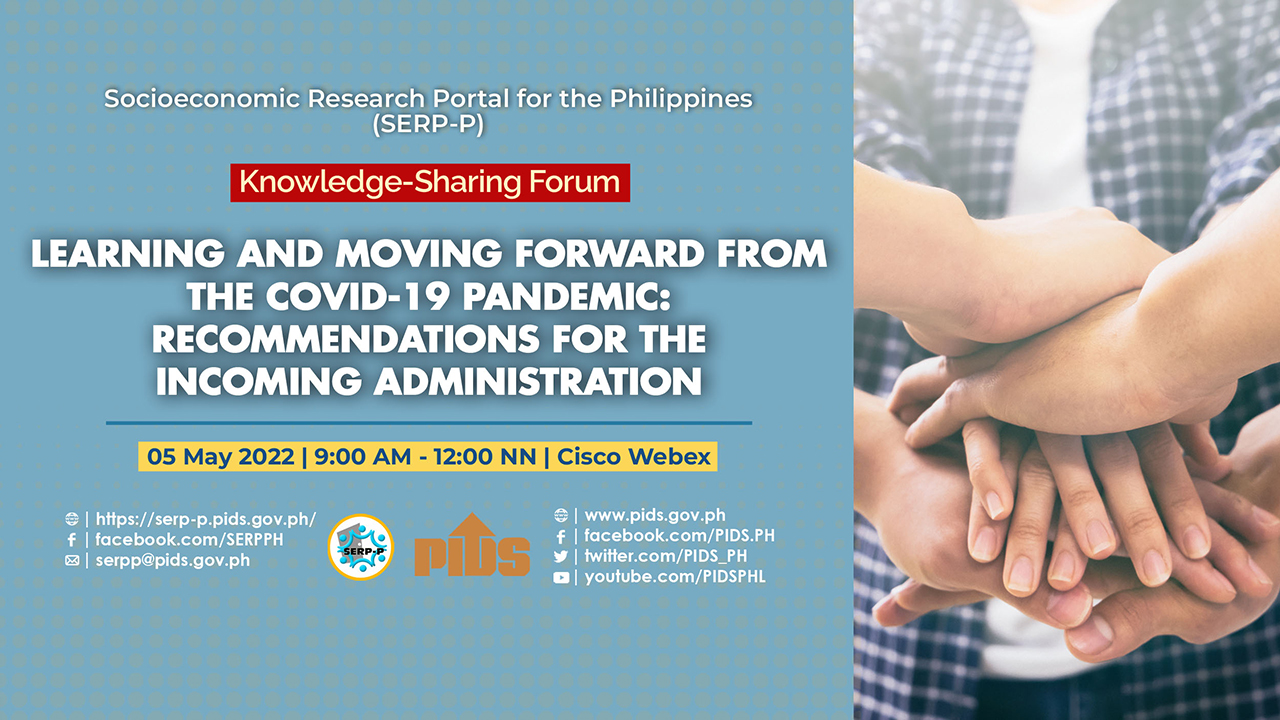Granting financial aid to poor but deserving students to enroll in college is not enough. Government must help ensure these grantees finish their education through a proper selection process.
These were the recommendations presented by the latest study released by state think tank Philippine Institute for Development Studies (PIDS).
Authored by PIDS consultant Denise Valerie Silfverberg, the study “How should income-based grantees in tertiary education be chosen?” is a preliminary review of the Students Grants-In-Aid Program for Poverty Alleviation (SGP-PA) of the Commission on Higher Education (CHED) and the Department of Social Welfare and Development (DSWD).
As a “form of affirmative action”, SGP-PA provides financially constrained but deserving students the opportunity to obtain college degrees and “break the cycle of poverty”. A related PIDS study published in 2013 found that the higher a person’s educational attainment, the better are his chances to get employed and earn higher wages.
CHED and DSWD plan to expand the number of the program’s recipients to 36,000 from the current 4,000 in the current academic year. Since the program was first implemented in AY 2012-2013, CHED selected the SGP-PA candidates from the DSWD’s list of Pantawid Pamilyang Pilipino Program (4Ps) households. Selection was based on the following criteria: the candidates must be 16–30 years old; have completed high school; are not receiving a scholarship, grant, or funding; and must come from households who do not have any other college graduate.
The complex challenges to the SGP-PA’s success became more obvious when the selection process was put under the discretion of the state universities and colleges (SUCs).
By looking at the selection and implementation stages of the program, and analyzing available data from two SUCs, Don Mariano Marcos Memorial State University (DMMMSU) and Mindanao University of Science and Technology (MUST), Silfverberg identified some problems and provided possible interventions to fine-tune the program.
For example, having different policies to accommodate the program contributed to the variations in the SGP-PA’s success rate. “The SUCs implementing the SGP-PA were requested to waive the entrance exams and accommodate the potential beneficiaries identified in their area. DMMMSU heeded this request but MUST enforced its admission process, albeit lowering the passing grade a little for the grantees,” she noted.
Comparisons between the household characteristics of grant recipients and ordinary tertiary students clearly reveal that the grantees were disadvantaged. These setbacks often affected the grantees’ abilities to perform well and finish their schooling.
Thus, it is essential, she says, that SUCs incorporate indicators such as admissions exams, social adaptation, and strategies to help grantees gain a developmental approach to their education.
“Between DMMSU and MUST, the latter proved more persistent when it came to intervening in several aspects of the grantees’ student life. MUST provided avenues for socialization, and helped induce improved academic performance through assigned student tutoring and by waiving summer school fees for grantees to retake failed subjects. Meanwhile, DMMMSU enforced a buddy system and likewise offered counseling,” explains Silfverberg.
The figures of grantees that dropped out of their college programs so far revealed the limits and complex challenges of the SGP-PA program. One reason, which is within the control of CHED and the SUCs, included the consequence of financial difficulties due to the fact that grantees did not receive their stipends on time.
Other reasons for dropping out were not related to academics, Silfverberg notes, such as pregnancy, health issues, familial obligations, behavioral issues, and homesickness. Meanwhile, 30 percent of grantees dropped out because they were uninterested or preferred to work.
Silfverberg recommends that CHED and DSWD refine their selection process and focus their efforts on finding candidate grantees that fit their initial criteria and who, at the same time, have the interest and ability to finish their education. “The best available tool for gauging this would be admission exams,” she said.
A more intensive and detailed information campaign of the availability of SGA-PA is also recommended. Those who are committed in sincerely obtaining tertiary education would avail of the program, which would improve the process of selection instead of scouting candidates from 4Ps beneficiaries.
She also recommends that SUCs take into consideration the cultural challenges experienced by the grantees when designing intervention programs. “These interventions are necessary for the program objectives to be met. Grantees have to be well-adjusted academically and otherwise, which would then lead to a considerably higher likelihood of completing tertiary education,” she concludes.
You may download the full study from this link: http://dirp3.pids.gov.ph/webportal/CDN/PUBLICATIONS/pidspn1419.pdf
These were the recommendations presented by the latest study released by state think tank Philippine Institute for Development Studies (PIDS).
Authored by PIDS consultant Denise Valerie Silfverberg, the study “How should income-based grantees in tertiary education be chosen?” is a preliminary review of the Students Grants-In-Aid Program for Poverty Alleviation (SGP-PA) of the Commission on Higher Education (CHED) and the Department of Social Welfare and Development (DSWD).
As a “form of affirmative action”, SGP-PA provides financially constrained but deserving students the opportunity to obtain college degrees and “break the cycle of poverty”. A related PIDS study published in 2013 found that the higher a person’s educational attainment, the better are his chances to get employed and earn higher wages.
CHED and DSWD plan to expand the number of the program’s recipients to 36,000 from the current 4,000 in the current academic year. Since the program was first implemented in AY 2012-2013, CHED selected the SGP-PA candidates from the DSWD’s list of Pantawid Pamilyang Pilipino Program (4Ps) households. Selection was based on the following criteria: the candidates must be 16–30 years old; have completed high school; are not receiving a scholarship, grant, or funding; and must come from households who do not have any other college graduate.
The complex challenges to the SGP-PA’s success became more obvious when the selection process was put under the discretion of the state universities and colleges (SUCs).
By looking at the selection and implementation stages of the program, and analyzing available data from two SUCs, Don Mariano Marcos Memorial State University (DMMMSU) and Mindanao University of Science and Technology (MUST), Silfverberg identified some problems and provided possible interventions to fine-tune the program.
For example, having different policies to accommodate the program contributed to the variations in the SGP-PA’s success rate. “The SUCs implementing the SGP-PA were requested to waive the entrance exams and accommodate the potential beneficiaries identified in their area. DMMMSU heeded this request but MUST enforced its admission process, albeit lowering the passing grade a little for the grantees,” she noted.
Comparisons between the household characteristics of grant recipients and ordinary tertiary students clearly reveal that the grantees were disadvantaged. These setbacks often affected the grantees’ abilities to perform well and finish their schooling.
Thus, it is essential, she says, that SUCs incorporate indicators such as admissions exams, social adaptation, and strategies to help grantees gain a developmental approach to their education.
“Between DMMSU and MUST, the latter proved more persistent when it came to intervening in several aspects of the grantees’ student life. MUST provided avenues for socialization, and helped induce improved academic performance through assigned student tutoring and by waiving summer school fees for grantees to retake failed subjects. Meanwhile, DMMMSU enforced a buddy system and likewise offered counseling,” explains Silfverberg.
The figures of grantees that dropped out of their college programs so far revealed the limits and complex challenges of the SGP-PA program. One reason, which is within the control of CHED and the SUCs, included the consequence of financial difficulties due to the fact that grantees did not receive their stipends on time.
Other reasons for dropping out were not related to academics, Silfverberg notes, such as pregnancy, health issues, familial obligations, behavioral issues, and homesickness. Meanwhile, 30 percent of grantees dropped out because they were uninterested or preferred to work.
Silfverberg recommends that CHED and DSWD refine their selection process and focus their efforts on finding candidate grantees that fit their initial criteria and who, at the same time, have the interest and ability to finish their education. “The best available tool for gauging this would be admission exams,” she said.
A more intensive and detailed information campaign of the availability of SGA-PA is also recommended. Those who are committed in sincerely obtaining tertiary education would avail of the program, which would improve the process of selection instead of scouting candidates from 4Ps beneficiaries.
She also recommends that SUCs take into consideration the cultural challenges experienced by the grantees when designing intervention programs. “These interventions are necessary for the program objectives to be met. Grantees have to be well-adjusted academically and otherwise, which would then lead to a considerably higher likelihood of completing tertiary education,” she concludes.
You may download the full study from this link: http://dirp3.pids.gov.ph/webportal/CDN/PUBLICATIONS/pidspn1419.pdf












